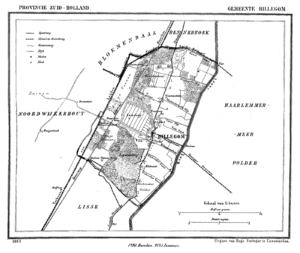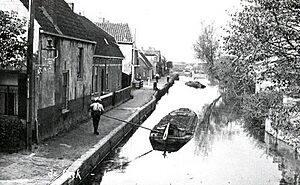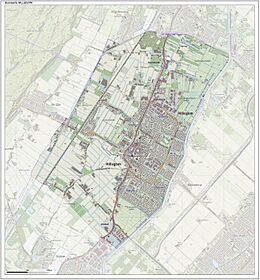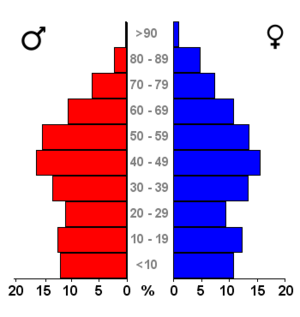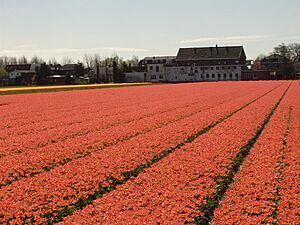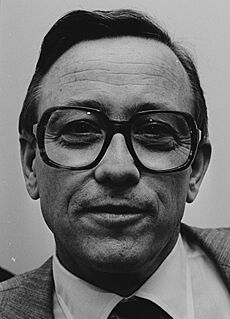Hillegom facts for kids
Quick facts for kids
Hillegom
|
|||
|---|---|---|---|
|
Town and municipality
|
|||
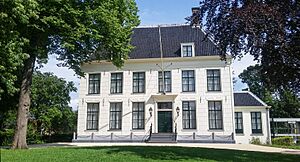
Hillegom Town Hall
|
|||
|
|||
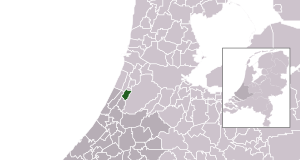
Location in South Holland
|
|||
| Country | Netherlands | ||
| Province | South Holland | ||
| Government | |||
| • Body | Municipal council | ||
| Area | |||
| • Total | 13.48 km2 (5.20 sq mi) | ||
| • Land | 12.92 km2 (4.99 sq mi) | ||
| • Water | 0.56 km2 (0.22 sq mi) | ||
| Elevation | 1 m (3 ft) | ||
| Population
(May 2014)
|
|||
| • Total | 21,090 | ||
| • Density | 1,632/km2 (4,230/sq mi) | ||
| Demonym(s) | Hillegommer | ||
| Time zone | UTC+1 (CET) | ||
| • Summer (DST) | UTC+2 (CEST) | ||
| Postcode |
2180–2182
|
||
| Area code | 0252 | ||
Hillegom is a town and a local government area (called a municipality) in the western part of the Netherlands. It is located in the province of South Holland.
Hillegom is part of a special area known as the Duin- en Bollenstreek. This name means "Dune and Bulb Region." For a long time, the main way people made a living here was by growing beautiful bulb flowers.
The name Hillegom comes from an old abbey (a type of monastery) called Hijlighem. This name meant "Holy Home" in an old language called Old Frankish. That abbey no longer exists today.
Contents
Hillegom's Rich History
Hillegom started on the eastern edge of the sandy dunes near the coast. It was where an old road from Leiden to Haarlem crossed a stream called the Hillegommerbeek. This spot was also close to the shores of a large lake, the Haarlemmermeer.
Early Beginnings Before 1000 AD
Places with names ending in "-heim" (like Hillegom) usually began before the year 1000. So, people think Hillegom is very old. Around 1150, the leader of Egmond Abbey had the right to choose priests in Hillegom. This shows that a church or chapel was already there. In 1248, Count Willem II gave the Chapel of Hijllinghem to the Abbot of Egmond.
Growing Importance in the Middle Ages
In the mid-1300s, Hillegom became more important. The counts of Holland met there three times to make important decisions. In 1369, Hillegom had 46 houses and 283 people. By 1477, it had grown to 67 houses and 412 people.
Challenges and New Growth
During the Eighty Years' War, Hillegom was caught between the Spanish and Dutch rebel armies. In 1577, the town was almost completely destroyed. But after the mid-1600s, the area became rich again. This was thanks to growing fruits and vegetables. These crops grew well in the sandy soil of fields that were dug out from the dunes.
The Influence of Wealthy Merchants
In 1722, a rich merchant from Amsterdam named Jan Six II bought the area of Hillegom. He made many improvements to the town. He built a stone bridge over the Hillegommerbeek and a water pump in the village square. He also paved part of the main road. In 1749, he bought Het Hof (The Courtyard), a large estate in the center of Hillegom.
At this time, many other rich merchants and important leaders (called stadtholders) had estates in Hillegom. Some of these estates were named Bethlehem, Oostende, and Elsbroek. Many of these old names are still used for neighborhoods today. The town's population continued to grow, reaching 930 people in 1732 and 1050 in 1795.
Changes in the 19th and 20th Centuries
In 1855, Hillegom became bigger by joining with the nearby municipality of De Vennip. During the 1800s, the beautiful estates and natural areas slowly started to disappear. Land developers bought the estates, cut down the forests, and dug up the sand dunes. They did this to create more fields for growing bulb flowers.
This process sped up in 1904 when a factory was built south of Hillegom. This factory made bricks from lime and sand, and it needed a lot of sand. By the early 1920s, almost all the old estates were gone. Only Het Hof remained, and it became Hillegom's town hall. At the same time, the bulb flower industry grew very quickly. Hillegom's population also grew fast, reaching 8,800 people by 1916.
Hillegom's good location led to another period of fast growth in the 1960s, 70s, and 80s. Many new neighborhoods were built for families who worked in Haarlem, Amsterdam, or Leiden. The town's economy became less focused on flower bulbs. It became more varied with new business parks.
Hillegom's Geography
Hillegom is surrounded by other towns. To the north are Bloemendaal (and what used to be Bennebroek). To the east is Haarlemmermeer. To the south is Lisse, and to the west is Noordwijk (which used to be Noordwijkerhout). The municipality of Hillegom covers an area of about 13.48 square kilometers. A small part of this, about 0.62 square kilometers, is water.
Local Neighborhoods
Hillegom has several different neighborhoods where people live. These include:
- Centrum (the town center)
- Elsbroek
- De Marel
- Meer en Dorp I and II
- Patrimonium
- Treslong
- De Zanderij
- Hofzicht
- Weerestein
- Amerikabuurt
- Hillegom Zuid
- Vossepolder (a new area still being built)
Population Growth in Hillegom
The number of people living in Hillegom has changed over the years. Here's how the population looked on January 1st of different years:
- 1899: 5,361 people
- 1930: 10,812 people
- 1960: 14,789 people
- 1970: 16,963 people
- 1980: 17,937 people
- 1990: 19,885 people
- 2000: 20,664 people
- 2004: 20,588 people
- 2006: 20,317 people
- 2011: 20,627 people
- 2017: 21,629 people
- Source: Statistics Netherlands
Getting Around Hillegom
In the past, people in Hillegom often traveled by water. They used canals or streams to move goods and people.
Waterways for Transport
The Hillegommerbeek (Hillegom's Creek) was important for moving goods from the town to the Haarlemmermeer lake. After the lake was drained, the creek connected to the Ringvaart canal. You can still see several docks and wharfs along the creek and canal today.
The Leidsevaart (Leiden Canal) was finished in 1657. It runs between Leiden and Haarlem, just west of Hillegom. This canal is not used much anymore because many of its bridges cannot be opened.
Roads and Railway Connections
Hillegom is connected by Provincial Roads 207, 208, and 442.
The town also has a train station, Hillegom railway station. From here, you can take direct trains north to Haarlem and south to Leiden and The Hague.
Things to See and Do in Hillegom
The best time to visit Hillegom is in the spring. This is when the fields around the town burst into bloom with colorful flowers. During this time, a special flower parade called the Bloemencorso travels through Hillegom's main streets. It's a truly amazing sight!
Hillegom was once home to the Den Hartogh Ford Museum. This museum had the world's largest collection of Ford cars. It featured over 200 classic cars, all made before World War II. The museum closed in 2016.
Famous People from Hillegom
Many interesting people have come from Hillegom:
- Adriaan van der Willigen Pz. (1810–1876) was a doctor and a historian.
- Dr. Willem Pleyte (1836–1903) was an expert in ancient Egypt (an Egyptologist) and a museum director.
- Jacob Cornelis van Slee (1841–1929) was a Dutch Reformed clergyman and a scholar.
- Constantijn Muysken (1843–1922) was a well-known architect.
- Piet van Zeil (1927–2012) was a Dutch politician and a leader in trade unions.
- Hans 't Mannetje (1944–2016) was a Dutch sculptor, famous for making gable stones (carvings on buildings).
- Wim Turkenburg (born 1947) is an academic who studies energy and environmental issues.
- Thea de Roos-van Rooden (born 1949) is a historian and former politician.
- Annemarie Spilker (born 1980) is a Dutch photographer.
Sports Personalities
- Dick van Egmond (born 1961) is a soccer referee.
- Jesse Huta Galung (born 1985) is a former professional tennis player who lives in Hillegom.
- Marc Evers (born 1991) is a Dutch Paralympic swimmer.
Images for kids
See also
 In Spanish: Hillegom para niños
In Spanish: Hillegom para niños




